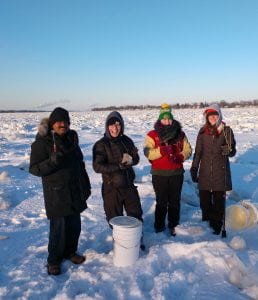
We always are looking for something new and novel research that pushes the research front farther. For example, our ongoing Arctic research involved collection of snow, water from melt ponds (these are small ponds that are less than 2 feet deep and the water mostly derived from snow and ice melt; the salinity is often less than 5 parts per thousand (ppt) while surface ocean water salinity varies between 20-35 ppt), ice core and ice-rafted sediments (dirty ice) in the Arctic Ocean and establish a new method determining the ‘age’ of snow, melt-pond, ice-rafted sediment (IRS), etc. This proposed study has direct bearing to the radiation balance in the Arctic (note: Albedo of fresh snow is ~70% but seawater has ~30% (which implies that 70% of the incident heat is reflected to the atmosphere by snow and ice, but with no ice and snow, 70% of the incident heat is taken by surface seawater resulting in ocean warming which subsequently melt more ice and snow – Positive feedback!).
The major focus of the NSF-RAPID grant, funded in February 2019, is to investigate how sediment gets incorporated in ice, a process very similar to sediment incorporation in the coastal Arctic Ocean. The once-in-a-lifetime weather condition we had in February 2019, when the complete Lake St. Clair remained frozen for a few days, provided a unique opportunity to collect a number of ice samples and we measured 7Be, 137Cs, 210Po and 210Pb in sediment extracted from ice as well as in ice. We are finding that the 210Pb activity in sediment laden in ice is more than 100 times higher than the bottom sediment in the lake. This implies that particle-reactive contaminants are highly concentrated in ice-sediment and dispersed during the ice melt. Initial data is very exciting and looking forward to disseminating the results in a high-end journal. One of the undergraduate students (Lathan Saperstein) will be presenting this result at the Fall-2019 American Geophysical Union meeting. We also have ongoing funded collaborative research with a number of institutions that include US Army Corps of Engineers, University of Berkeley, among others, that deal with source identification, sediment accumulation/erosion rates in coastal marine environments and lakes using 234Th, 7Be and 210Pb as tracers and chronometer.
Currently, we are planning to collect Road dust in the Metro Detroit area to tag the source(s) and transport of road dust using the same set of radionuclides listed above. The field sampling is scheduled this week (8th August 2019). This is expected to be a graduate student’s (Max Denny) thesis work
